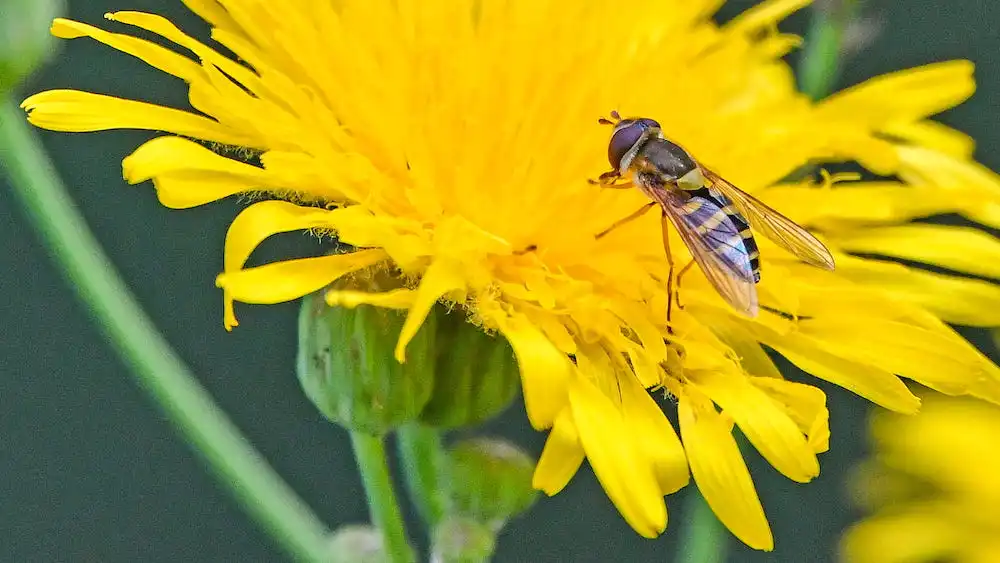Treed borders provide a base for pollinating, pest-eating insect in crops, study shows.
Planting and maintaining a border of trees around agricultural fields will help a family of flies that, in turn, is important to crops, according to a recent University of Alberta study.
Treed field borders supplied over 33 times more hoverflies to canola fields than grassy borders, the research shows.
That’s good news for showing how to get the most benefit from the insects in supporting the crops, says Rachel Pizante, a PhD student in conservation biology who led the study.
The family of flies, which resemble bees and wasps, move between the fields and their borders, feeding on nectar and pollen from blooming crops such as canola. In the process, they pollinate the crops, which can boost yield. But the insects also provide a double benefit — their larvae often feed on soft-bodied crop pests like aphids and thrips.
The study provides more knowledge about how to make the most of the services the insect can provide to crops, says Pizante, of the Faculty of Agricultural, Life & Environmental Sciences.
“From an agricultural perspective, the findings mean we can get more bang for our buck,” she says. “Planting more treed field borders will keep the adults as pollinators in the crops, and they’ll then produce larvae, which leads to more pest control.”
Pollinators and pest controllers
It’s important to learn more about hoverflies, which tend to be overshadowed by more commonly known pollinators such as bees, Pizante adds.
“Bees can pollinate but they don’t have a role in pest control. And other insects, such as some beetles, have larvae that can control pests, but many of them don’t pollinate crops. Hoverflies are a major group of common insects that can provide both services.”
Using 10 canola fields located in central Alberta, each with at least one treed and one grass border, Pizante measured the insects’ back-and-forth movement between the fields and their borders.
The borders with trees and shrubs supplied, on average, almost 85,000 hoverflies per kilometre per week to canola fields, but grassy borders supplied only about 2,500 of the insects, the study showed.
“This means treed borders should be good for crop pollination, because they seem to both produce more hoverflies and keep them in the field,” Pizante notes.
Very few of the insects moved back from the field into the treed border, the researchers also found. They suggest that the one-way pattern of movement is likely because the treed edges don’t offer much habitat for adult hoverflies — though they do offer marshy areas and decaying deadwood that provide a good environment for females to lay their eggs and for larval feeding, Pizante adds.
“We found a greater proportion of hoverflies and larvae that feed on dead organic matter moving from the treed borders than from the grassy borders, which explains the increase in total hoverflies coming from treed borders, compared to grass borders.”
The study, which identified 96 species of the insect, also found that the treed borders supported twice the diversity of hoverflies compared with grass perimeters, again likely due to more resources available to the flies’ larvae in those areas.That means there’s a higher diversity among species of the insect to provide ecosystem benefits beyond agriculture. These additional benefits would include pollinating wildflowers and feeding on deadwood, turning it into soil nutrients.
“That’s a win for conservation,” Pizante says. “These species might not all benefit agriculture, but treed borders are a better way to keep this diversity of hoverflies on the landscape than are grassy borders.”
Tool for landowners
The study also showed that any type of treed border would be useful to keeping hoverflies in and around crops.
The researchers examined whether any single aspect such as tree density, border width, grass height or woody debris affected the supply of the hoverflies from treed borders, but none stood out, Pizante says.
“That means any treed border should be capable of supplying enough hoverflies to potentially increase crop yields; there’s not a lot of tweaking needed. For example, the borders wouldn’t need to be planted in certain ways,” she says.
“It also means that if a landowner wanted to plant a treed border for other purposes like mitigating soil erosion, it would benefit the hoverflies, too.”
Treed borders are an important tool for landowners interested in nature-based solutions, Pizante says. Measures like planting wildflower strips in or near crops, for example, encourage pollination by bees but won’t produce hoverflies to the same extent that a treed border will.
“As landowners become more interested in pollinator conservation, treed borders provide another intervention.”
The study’s co-authors include assistant professor Carol Frost, faculty service officer John Acorn and PhD student I. Pilar Jimenez, all based in the Faculty of Agricultural, Life & Environmental Sciences.
The research was supported by funding from the Natural Sciences and Engineering Research Council of Canada and the Alberta Conservation Association.
Read the paper: Agriculture, Ecosystems & Environment
Article source: University of Alberta
Author: Bev Betkowski
Image: Hoverflies — a family of insects that pollinate crops and control pests — get a boost from planting and maintaining trees around fields, according to a U of A study. Credit: John Acorn.






